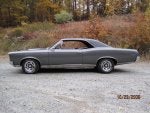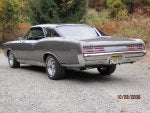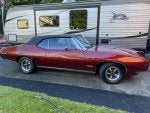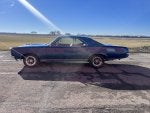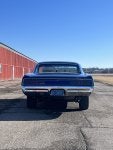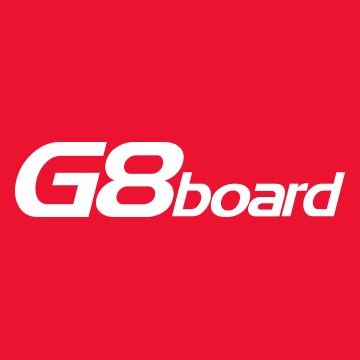HUB CENTRIC
A-Body - 4.75" Bolt Pattern -The stock rim width is 6 inches and later 7 inches starting around 1969/70 for both 14" and 15" rims.
B-Body 5.0" Bolt Pattern.
Bolt Pattern Torque/Tighten Sequence
Pic # 1 - 5 X 4.75 Bolt Pattern Torque Sequence Specifications: 1, 3, 5, 2, 4
You don't have to follow the sequence as shown as #1 could be at the top of your starting sequence - it is where ever you begin, but then follow the sequence tightening across from the last one you tightened and so on. Never tighten by going around in a circle.
Alloy wheels should always be installed using a torque wrench ensuring proper mount. Check your owner's manual or manufacturer's specifications for proper torque numbers.
Hub Center Bore
What is it? On your A-body Pontiac, and A-body GM cars, it is the wheel/rim center hole/bore and should be 2.783" to 2.786" diameter and fit snug over the front/rear axle center hub.
Pic #2 - shows the center flange on an axle that the brake drum and rim slip over.
Pic # 3-#5 - Hub Center Bore
is the center hole in the wheel that centers the wheel on the front/rear hub of the car - that protruding circular flange that the drum slips over. Think of it as an alignment dowel pin which also supports the rim and car's weight. Since most aftermarket wheels are mass produced, they can have a large center bore to accommodate several different vehicles.
IF this is the case, it is recommended that you use a hub ring. Hub rings are hard plastic or metal ring that fits between the wheel and the vehicle. This centers the wheel perfectly on the hub ensuring that there is no run out when the wheel is installed on to the vehicle. Without hub rings it is possible to get vibrations even if the wheel / tire assembly is perfectly balanced.
Hub-Centric Rings
Most aftermarket wheels have a large center hub diameter so the wheels will fit a variety of different vehicles. The Hub-Centric Rings are made to fit between the rim's center hole and the axle center flange of a vehicle - that gap created between the larger rim center hole and the smaller hub of the vehicle when a mismatch is encountered so as to ensure the wheel is perfectly centered. This not only makes the installation of your new wheels much easier but will also help eliminate any vibrations you may encounter. It also allows the rim to ride on the axle hub rather than ride on the lug nut studs which can fail and cause the rim/wheel to fall off at the worst time.
I personally had this experience in my youth when I used a set of aftermarket flat style chrome slotted rims that had a larger center hub diameter than the center hub flange of the front axle. All the weight of the car was being applied to the lug nut studs. Doing 55MPH in the 1965 Chevy convertible with the family in the car, the wheel broke off and the car dropped to the ground in an instant and control was lost. The car veered to the left and literally ran up onto the adjacent steel safety guard rail where it was at its starting point that began at ground level and then went up. A wrecker had to lift us off the guard rail and tow the car home - could have been a killer type accident with the family inside. All the wheel studs had been sheared off because all th car's weight had been put only on those studs. The day before I had been doing over 100MPH traveling back roads that ran along and through several lakes and no guard rails - that could have been a fun ride if the studs had sheared off then, and I hate drowning and sudden stops by big oak trees.
Hub rings are sized using two different numbers that are typically measured in millimeters. The larger number is the diameter of the center bore on the wheel and is the outside diameter of the hub ring. The smaller number is the diameter of the hub on your vehicle and is the inside diameter of the hub ring. These rings can be purchased from a supplier or have your local machine shop make the ring with your dimensions given.
The rings can be made of a nylon material because it is inexpensive, offers high tensile strength, chemical resistance, stiffness and extreme temperature tolerance along with low thermal expansion. It will not rust or corrode, and is also has a low friction property that helps with longevity and won’t rattle or squeak.
Machined aluminum hub-centric rings are extremely strong, and won’t rust. They are ideal for those who participate in autocross, track days or tinker with their cars for more than the occasional maintenance and tire rotation. When removing frequently, plastic rings can get dropped, stepped on, etc. and are prone to breaking while
aluminum hub rings are virtually indestructable. You can also have the rings made in steel if selecting a local machine shop to fabricate a set - I had this done for a set of 4-wheel truck rims having the larger center hole diameter for the 4-wheel drive hub so they would fit my '68 Lemans, but have since opted for a different rim.
Rim Spacers
Pics # 6 & #7 - I am not a fan of rim spacers. Get the correct rim/tire combo and know their limits. Don't use a tire or rim too wide and "I just need another 1/2" away from my frame and the tires will fit perfect." But if you do, get a spacer that has a hub-centric flange that your rim will fit on to. A flat spacer without the hub-centric flange brings you right back to the cautions above, all the weight of the car is now resting on the wheel studs because the spacer has mover the wheel off the hub center of the axle which is where the weight of the car is supported. Included pictures of a "bad" spacer design and as example, a hub adapter having the hub-centric flange for the new rim. Again, just get the correct rim and you do not have to worry.





